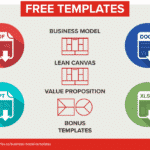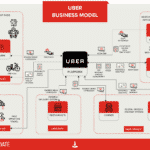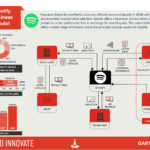Tesla is an American electric car and power-train designer, developer, manufacturer and distributor headed by CEO and serial entrepreneur Elon Musk. The Tesla business model is a direct to customer offer.
Table of Contents
What Makes Tesla So Different Than Its Competitors.
Digital Technolgy
The Tesla car is a computer on wheels.
Unlike other car manufacturers, Telsa is born digital. Because of that digital focus, Tesla has some fundamental differences built into its DNA.
When Elon Musk started Tesla he approached the car industry with a different mindset – technology first.
As an entrepreneur and technologist, he started the design of Tesla with technology as the start. As an example, the system software receives software updates.
This contrasts with other manufacturers whose tech and infotainment quickly becomes dated during the time you own the car. With a Tesla it keeps getting better!
Right from its infancy, Tesla has focused on offering the best technology ever to go into a car. The result is a frictionless and easy to use experience with such features as:
- Autopilot – drive on autopilot.
- Dashboard Smartscreen – which features a slew of clever apps.
- Smart summon – move your car out a parking space using the phone app.
Direct To Consumer
The car industry is based on dealerships, middlemen.
Rather than use dealerships as a route to market, Tesla decided to go direct and cut out the middlemen, essentially decoupling part of the supply chain.
To buy a Tesla you can either go to one of their own showrooms – essentially a shop or buy directly online. This B2C business model improves Tesla’s overall margin.
Clean Eco-Friendly Value Proposition
A final key part of the business model and one of the most important is the electric storage technology. Tesla continues to lead the industry in terms of energy storage. The result is that Tesla cars deliver the longest range and fastest performance of any electric car in the market.
As an example, the Tesla Roadster is the fastest car in the world – going from 0 to 60 mph in 1.9s.

The vision is to create a cleaner world by reducing CO2 emissions and overall pollution.
Key Facts About TESLA

| Company name: | TESLA, Inc. |
| Founders: | Elon Musk, Martin Eberhard, JB Straubel, Marc Tarpenning, Ian Wright |
| Annual revenue: | (FY 2019): $24.5 Billion |
| Profit | Net Income: | (FY 2019): $775 Billion |
| Market Cap: | (May, 2020): $148 Billion |
| Launch date: | June 22. 2012 Tesla Model S launch |
| Year founded: | 2003 |
| Company CEO: | Elon Musk |
| Headquarters: | Palo Alto, California |
| Link: | Tesla |
| Number of employees: | (FY 2019): 48,016 |
| Type of business: | Public |
| Ticker symbol: | TSLA |
| Products And Services: | Model S, Model 3, Model X, Model Y, CyberTruck, Roadster, Energy (commercial and domestic) |
| Company Competitors: | Audi eTron, Mercedes EQC, BMW i8, Porsche Taygan, Jaguar iPace, BYD Company iPro |
Interesting Fact: Elon Musk is the longest-tenured CEO of any automotive manufacturer globally.
Who owns Tesla?
Elon Musk holds over 38 million stocks, which equates to a 21.7% ownership in the company which at a market capitalization of $100 Bn would make his share worth $20 Bn. Other key stakeholders include Baillie Gifford & Co with 7.7% and other capital and venture capital firms like FMR LLC, and Capital Ventures International.
Is Tesla profitable?
Telsa posted a net loss of $775M in 2019 which is lower than its 2018 loss of over $1 billion. However, in the final quarter of 2019, Tesla posted a profit of $132 million. It’s worth noting that at this moment in time, Tesla is expanding its operations.
Is Tesla worth more than GM?
On February 19th, 2020 Tesla reached a market capitalisation of $169.16 billion, an all-time high for Tesla. To put that into perspective, Tesla’s valuation now exceeds that of Ford and GM combined.
Introduction To TESLA
It looked like the car market already had enough players. Let’s face it the amount of investment needed to compete in the car industry presents a significant barrier to entry.
Infrastructure, technology, production plants, distribution networks aren’t something you can simply conjure up on a whim.
Yet, Tesla had the vision to transform the industry by producing electric cars. Their goal was to leapfrog rivals who were rigidly committed to cars fuelled by petrol/diesel. At a time when electric batteries were nowhere near the performance level of today that was a brave vision to pursue.
They faced significant technological barriers but overcame them and now they have the worlds most efficient electric car is the Tesla Model Y.
In 2020, Tesla expects to deliver more than 500,000 vehicles, up 36% from 2019. Those are impressive growth figures for the brash startup are proving that the sceptics are wrong.
At the start of 2020, Tesla was also the best performing automaker in terms of total return, sales growth and long-term shareholder value.
As of December 2019, Tesla had over 13,000 charge points across the globe. This global network of charging stations is one part of the “competitive moats” that offers protection from other electric vehicle makers.
Tesla benefits from having fewer parts than an internal combustion vehicle making the total cost of Tesla ownership is significantly lower. There’s no need for expensive tune-ups and replacements.
In the US, Tesla charge points account for between 30 to 40 per cent of all charge points. Clearly this not only creates broader brand awareness but also improves the customer experience, reduces friction when making a purchase decision and provides a physical infrastructure footprint.
With more and more competitors playing catch-up to Tesla it is not to say that the Tesla Business model will not face competition. However, Tesla is creating unique defensible strategies that ensure it will maintain its lead in electric vehicles.
Tesla’s Corporate Mission and Vision
| Mission Statement: | Tesla’s mission statement was “to accelerate the world’s transition to sustainable transport.” However, in mid-2016, under Elon Musk’s leadership, the company changed the corporate mission to “to accelerate the world’s transition to sustainable energy.” |
| Vision Statement: | To create the most compelling car company of the 21st century by driving the world’s transition to electric vehicles. |
The TESLA Ecosystem
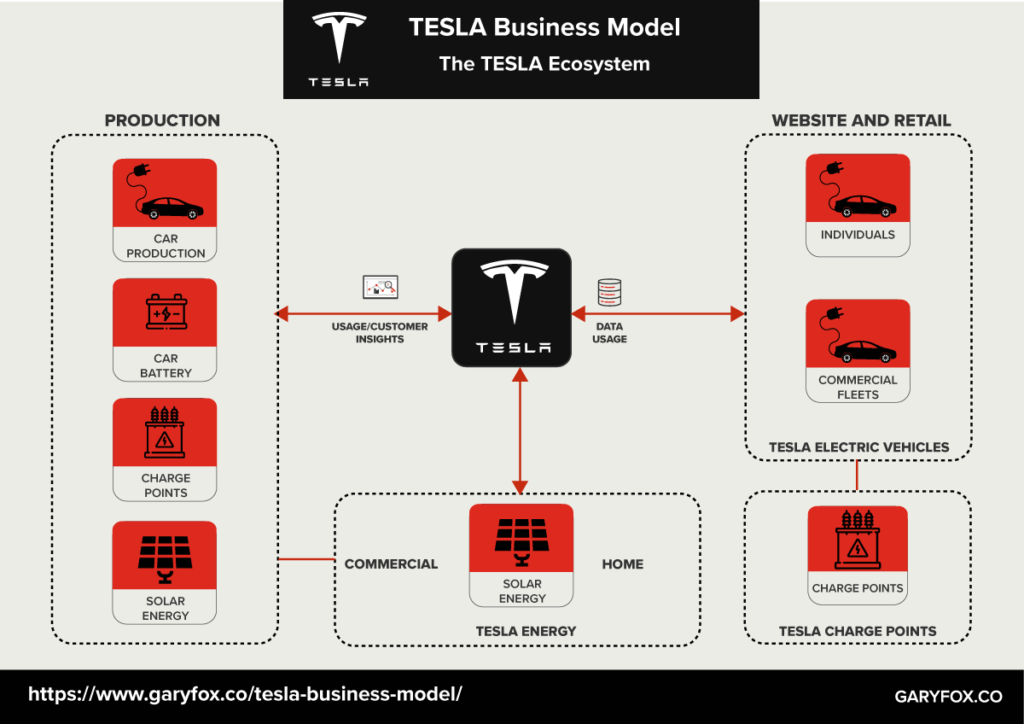
Tesla manufactures, distributes and sells the following products:
- Automobiles
- Electric vehicle powertrain components
- Batteries, energy storage
- Solar panels
To create an entire sustainable energy ecosystem, Tesla also manufactures a unique set of energy solutions, Powerwall, Powerpack and Solar Roof, enabling homeowners, businesses, and utilities to manage renewable energy generation, storage, and consumption.
Tesla
Benefits of Electric Over Fuel Engines
- Mass distribution: Wheels can be driven directly with a motor at each wheel or the wheel can be the motor. The advantages of smaller masses at motor locations, where maximum force is required, allow for more freedom of design, lower centres of gravity and better handling opportunities. Flexibility in weight distribution also allows for more safety features to be built into the overall design.
- Energy conservation: Power can be regenerated using the vehicle’s latent momentum during braking.
- Refuelling depots: Refuelling depots can be set up almost anywhere at low cost and can be easily utilised without the need for monitoring.
- Car mass: Most of the weight will be in the battery with better more efficient batteries currently being developed.
- Vehicle emissions: There are no gas emissions and low noise emissions in a BEV.
TESLA Business Model Canvas
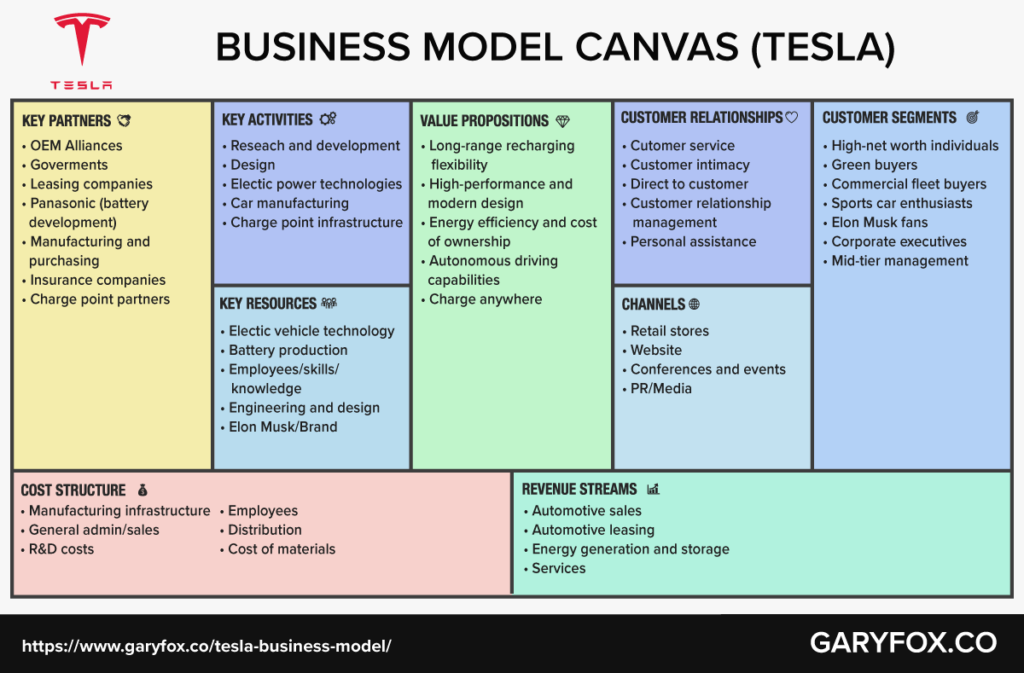
11 Ways The Tesla Model Disrupts The Automotive Industry
- Direct to the consumer: Unlike other car manufacturers who sell through franchised dealerships, Tesla uses direct sales.
- Service: Tesla has combined many sales centres with service centres. They believe that opening a service centre in a new area corresponds with increased customer demand. Customers can charge or service their vehicles at the service centres or the Service Plus locations.
- Electric vehicle performance: Tesla has the fastest car in the market and delivers the longest driving range from a full battery charge.
- Charging station ecosystem: Tesla has its own network of superchargers that charge 4X faster than normal chargers. Plus they are partnering with EVgo to create a bigger network of charge points.
- Design: Tesla has invested heavily in both the aesthetic and engineering of its EV. As a result, Tesla has a striking and unique brand identity and look.
- Sustainable energy: Tesla’s mission statement fits with a global need to have more sustainable sources of energy. Tesla’s cars and its broader ecosystem are helping to lower CO2 emissions.
- R&D investments: Tesla invests heavily in both hardware and software. But it is the focus on the digital technologies that have given it an advantage in the industry. Unlike other manufacturers, the Tesla infotainment system, like apps on your iPhone, get updated and continually improve.
- Software: Tesla collects data from all its cars, charge points and uses this to further innovate and develop new technologies and value propositions.
- Autonomous driving: Tesla is leading the way in autonomous and assisted vehicle driving.
- Partners: Tesla has a powerful network of partners including several governments that are supporting its production plants and infrastructure. Most governments have signed up to international agreements to lower carbon emissions and so Tesla aligns to their goals to achieve this.
- Elon Musk: The enigmatic serial entrepreneur continues to be controversial, but nobody can deny his incredible talent for pushing the boundaries of innovation as well as creating headlines in the press – essentially free publicity.
Key Points On The Tesla business Model
- The Tesla business model is a direct to customer (D2C) model that relies on an ecosystem of partners to deliver its value propositions.
- Tesla’s business strategy was to start in the luxury end of the market and then cascade down into the more popular and affordable models of cars for higher volumes.
- The luxury end of the car market drives the desire and brand prestige. The Roadster, Model S and Model X target the broader luxury market, while the Model 3 and the Model Y are aimed at the higher-volume mid-market segment.
- Tesla’s core focus is on technology and software. That makes it more agile, innovative and focused on data as well as the physical production of the vehicles.
- Tesla offers customers a car that doesn’t pollute the atmosphere, eliminates visits to gas stations, and is truly green. Tesla fits with the need to lower reliance on fossil fuels, cut CO2 emissions and adopt more sustainable energy solutions – solar energy.
What’s Tesla’s Value Proposition?
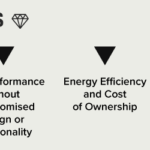
Tesla offers four core values to its customers:
1. Long Range and Recharging Flexibility
2. High-Performance Without Compromised Design or Functionality
3. Better Energy Efficiency and Cost of Ownership
4. Greener and more Eco-friendly Solution
Tesla provides state of the art EV models that offer eye-catching design, high-performance, long-range and above industry average energy efficiency.
Tesla’s Customer Segments

- The Tesla range of models include:
- Model S (Luxury sedan $74,500) – launched June 2012
- Model X (SUV $79,690) – launched September 2015
- Model 3 (mid-market $30,690) – launched July 2017
- Model Y (Compact $39,000) – launch 2020
- Semi-Truck (Commercial truck $tbc) – expected in 2020-21
- Tesla Pickup Truck – expected in 2020-21
- Tesla Roadster (Sportscar $200,000 plus) – Original model was in production from 2008-2012. The new version is expected in late 2020/early 2021.
Although Tesla produces what many consider to be luxury cars it is rapidly moving into the mid-market range which appeals to corporate fleet buyers and mid-tier management business.
However, the recently launched Roadster also places Tesla in the high-end sports car market and directly competes with traditional brands such as Porsche, Ferrari, Aston Martin and others.
Another key point is that Tesla is also moving into the commercial vehicle sector, which traditionally is one of the worst culprits for pollution.
TESLA Channels
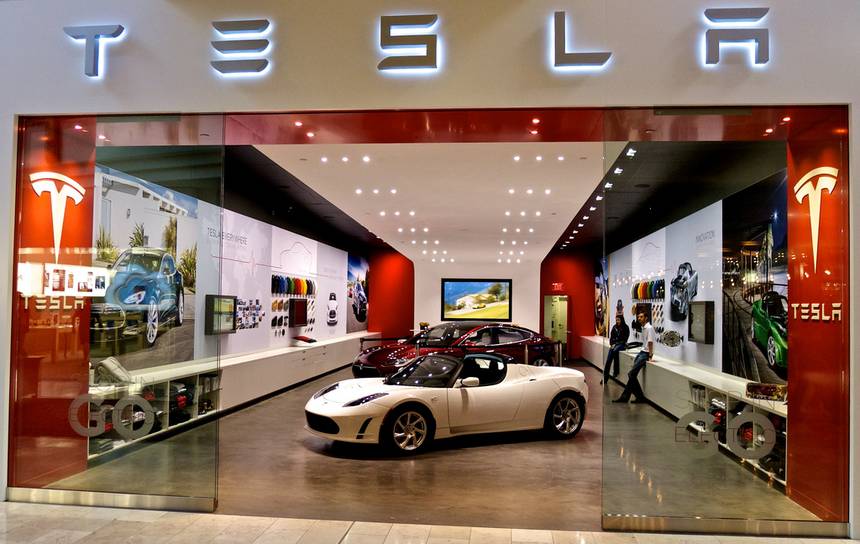
Tesla cuts out the middlemen. Buying a Tesla is relatively simple through the online shop. Compare this to buying other vehicles and you have layers of complexity and negotiation – dealers with sales teams who you have to negotiate with to get the final price (often not the one advertised).
How much does spend on marketing?
The company doesn’t spend on advertising. Instead, the company relies on word of mouth from its users and fans. Elon Musk is a celebrity serial entrepreneur and billionaire who attracts huge amounts of media attention and has a substantial social media following e.g. 33M followers on Twitter.
Tesla Customer Relationships
The Tesla business model block of Customer Relationships highlights the use of personalization, self-service and customer intimacy through its communications and app.
Tesla has focused heavily on delivering high-value customer experiences. The customer is firmly placed at the centre of the business. Ordering the car, communications, delivery and the app all provide seamless experiences that are highly personalized.
Customer Experience
- Omni-channel experience (stores, website, social media) to its customers.
- Company Owned Stores – Tesla utilizes direct to customer sales model. Tesla sells its cars to customers directly through its stores and galleries, instead of selling through auto dealers.
- Self Service website – Customers can easily place orders directly on the Tesla website. Moreover, customers can personalize their car build – add features, choose different colour combinations and find the best finance options.
Charging network
- Extension chargers provided for Model S, Model X and Model 3.
- A built-in navigation system that helps to identify and locate charger stations.
- Charging stations are designed to supercharge Tesla vehicles quickly.
- Tesla charging stations and app indicates when the vehicle charging is complete.
Key Activities of TESLA
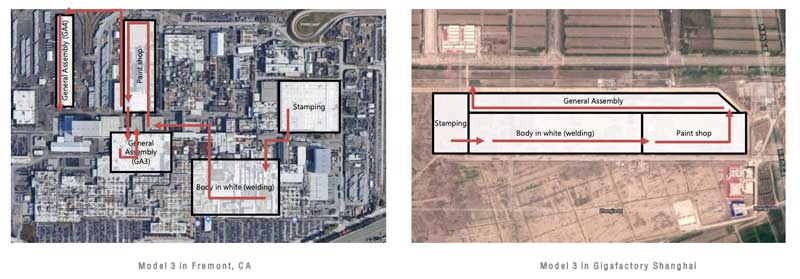
Manufacturing Cars
The core activities of Tesla are the production of electric vehicles, solar energy panels and energy storage (batteries). However, behind these capabilities sits the underlying resources and activities that enable Tesla to have the best EV in the market.
A significant moment is the opening of a new manufacturing plant in China and there are talks of a further plant in Brazil.
Design
Teslas stand out. Tesla cars make a statement. The fact they don’t have exhaust pipes and traditional petrol engines provided a new way to think about the aerodynamics and aesthetic appeal of the car.
The design ins sleek, modern minimalistic but at every point it provides the user with an easy and intuitive interface.
The Model S has been for sale since 2012, and it looks almost exactly the same today as it did back then, but it is still stunning and ahead of its time.
Research and Development
| R&D Spend – Year Ending 2018 | R&D Spend – Year Ending 2019 |
| $1,460 million | $1,343 million |
Tesla is in a race to continually innovate and improve the design of its cars, the efficiency of the batteries and the range of cars. To maintain its competitive position Tesla invest approximately 5.5% of its revenue into research and development. It’s worth noting that it also has several research partnerships with companies such as Panasonic.
Software Development
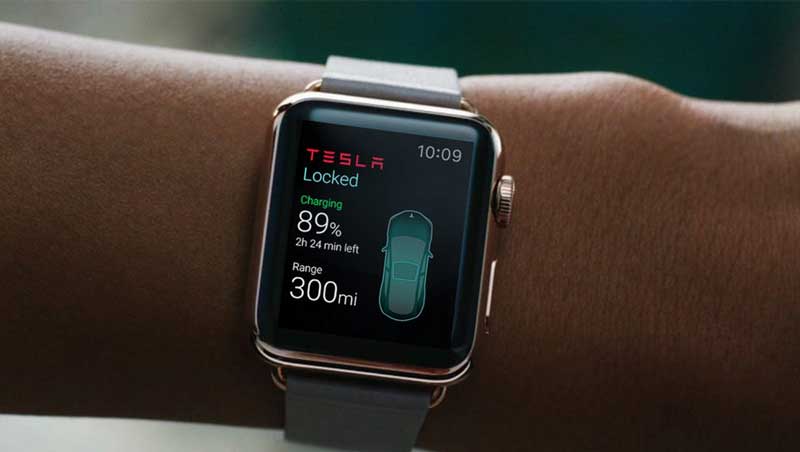
Elon Musk is an engineer, industrial designer who co-founded Zip2, a web software company, which was acquired by Compaq for $340 million in 1999. Musk then founded X.com, an online bank. It merged with Confinity in 2000, and was subsequently bought by eBay for $1.5 billion in October 2002.
Elon Musk knows software, it’s in his blood and how he thinks. It’s no surprise then that Tesla is ahead of the competition in terms of how the car uses the software. Tesla uses agile principles like “scrums” and “sprints” to develop and improve its software. But this process is also taking place in other parts of its business allowing it to rapidly design and innovate new models.
However, it is the data collection and insights that will help to propel its innovative approach to autonomous driving in the future. The Tesla business is predicated on an integrated ecosystem of chargers, vehicles and software.
Other manufacturers will rely on potential third-party partnerships with Google.
Charge Stations
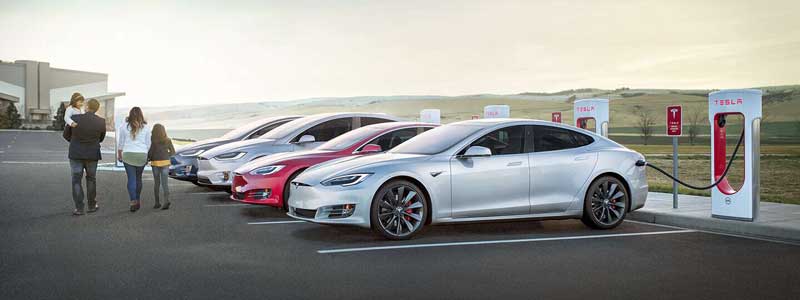
Tesla has built an extensive network of their supercharger and destination recharge stations around the world to expand the widespread adoption of its Electric Vehicles.
There are 1,870 Supercharger stations worldwide with 16,585 superchargers and thousands of Destination charging stations at hotels, restaurants, shopping centres, parking garages, office building, etc.
Tesla was also first to launch a portable home charger that costs about $500.
Key Partners of Tesla
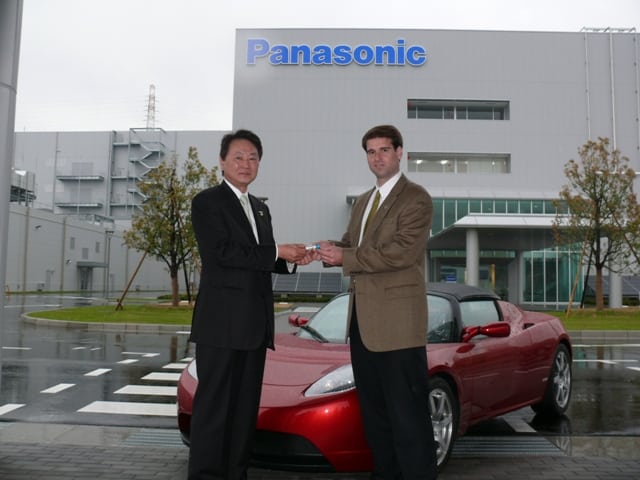
Powerful business models are a result of carefully aligning an organizations own capabilities with others to deliver the products and services that make it unique.
Tesla’s core competencies are its technological prowess in terms of innovation, manufacturing, design and software. However, Tesla needed more than that to suceed with electric vehicles it needed several strategic partners.
Charging points: Tesla partners with hotels, restaurants, shopping centres and resorts. Tesla has cemented a partnership deal with EVgo to expand the number of charge points in the US.
Telsa Partners with Panasonic
Tesla and battery maker Panasonic started working together in 2010 to develop nickel-based lithium-ion battery cells for electric vehicles. Naoto Noguchi, President of Panasonic’s Energy Company, said that the Japanese firm’s cells would be used for Tesla’s “current and next-generation EV battery pack.”
Panasonic’s has made an investment of over US$1 billion investment in facilities for lithium-ion cell research, development and production.
The relationship between Tesla and Panaosnic reached an agreement with Tesla to participate in Giga Nevada – the lithium-ion battery and electric vehicle subassembly factory near Reno, Nevada.
Government partnerships
Tesla has had significant investments in the form of government subsidies and allowances to buyers of Tesla’s cars.
Tesla buyers receive a $7,500 deduction from their annual U.S. federal tax liability. If the car is leased, the leasing company collects the $7,500 and lowers the payment to the buyer by a corresponding amount over the lease term.
Bloomberg Business News reported in November that a Tesla solar factory for which the State of New York paid $750 million based on a commitment to create 1,500 jobs.
TESLA Key Resources
- Design and Engineering: The outstanding design and engineering, e.g. the new roadster continues to lead the market.
- Technology: Tesla has leapt ahead of the other automotive manufacturers and continues to set new performance records for both distance and speed. But it isn’t just the vehicle, the software and integrations are far superior to anything else in the market.
- Big Data: Tesla is gathering masses much of which it has yet to monetize or use. The possibilities for third-party integrations and further development of the Tesla ecosystem could yield some interesting innovations.
- Open Source: Surprisingly, Tesla maintains an open-source policy and shares its intellectual property.
- Manufacturing: Although a youngster compared to other car manufacturers, Tesla is making big strides in terms of improving its production process. The main inefficiencies currently lie in the different base units used by each model.
- People: Tesla has over 48,000 employees, many of whom are the best in their field. Collectively Tesla has amassed experts from all over the world to tackle the innovation challenges involved in EV vehicles.
TESLA Cost Structure
In 2019, Tesla had revenue was $24.59 Billion, with the cost of revenues coming to $ 20.51 Billion. Tesla had a net income or net loss of -$775 million.
The following are Tesla expense and cost structure:
- Cost of material, labour & manufacturing overhead (COGS): $ 17.4 Billion, 81% of the revenue
- Selling, general & administrative Cost: $ 2.64 Billion, which is 10.7% of total revenue.
- Research & Development Cost: $ 1.34 Billion, which is 5.6% of the revenue
- Restructuring Cost: $ 149 Million, which is less than 1% of revenue
- Interest expense, taxes and others: about 3 % of revenue
TESLA Revenue Stream
Tesla’s principal revenue stream is the sales of its vehicles. Despite the heavy invested into its solar panel technologies and Solar City, it has not produced or sold any significant volumes.
| Revenue Source (millions of dollars) | Year Ending 2018 | Year Ending 2019 |
| Automotive Sales | $17, 632 | $19,952 |
| Automotive Leasing | $883 | $869 |
| Total Automotive Revenue | $18,515 | $20,821 |
| Energy Generation and Storage | $1,555 | $1,531 |
| Services and other | $1,391 | $2,226 |
| Total Revenues | $21,461 | $24,578 |
